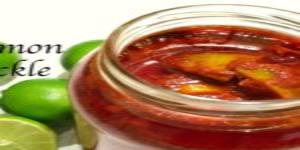
Scope
Pickling is a process by which a specific food’s shelf life is extended by using preserving ingredients such as salt, chillies, fenugreek seeds, turmeric, oil, etc. In India, there are a humungous variety of pickles, mango pickle being the most popular and favored one. However, perishable vegetables of different kinds, are also pickled to be preserved for several months, and sometimes even years. Pickles are stored in special jars called jadi as also earthen pots. Pickles (urgayum) are used as a complementary side dish and eaten with curd rice, conjee. Pickles are prepared once a year, especially when a particular vegetable or fruit is in season. For e.g. the period of March-April, which is the months when raw mangos begin to sprout on their trees, is busy month to prepare the mango pickle. A wide variety of mango pickles are
made such as the vada manga (tender mango), cut mango, shredded mango (from large raw mangoes), etc.
India is credited to being the first place in the world where pickling food began 1000s of years – going by the Bhaga Shastra, pickles are known to Indian civilization atleast from 60,000 years ago! “The Indian food scientist K. T. Achaya explains in his A Historical Dictionary of Indian Food that pickling is cooking without fire. He further adds that the Hindu text the Linga Purana (variously dated from 5th to 10th/15th CE) in Kannada language by Gurulinga Desika provides 50 pickle recipes, and achar also finds mention in the King of Keladi “Basavappa Nayaka” (r. 1697–1714 CE) work ?ivatattvaratn?kara.”
Fundamental Concepts and Principles
India has a large variety of pickles (known as achar in Nepali, Assamese, Bengali, Hindi, Punjabi, Urdu, uppinakaayi in Kannada, lonacha in Marathi, uppilittathu or achar in Malayalam, urgayam in Tamil, ooragaya in Telugu), which are mainly made from varieties of mango, lemon, lime, goongura (a sour leafy shrub), tamarind and Indian gooseberry (amla), chilli. Vegetables such as eggplant, carrots, cauliflower, tomato, bitter gourd, green tamarind, ginger, garlic, onion, and citron are also occasionally used. These fruits and vegetables are generally mixed with ingredients like salt, spices,
and vegetable oils and are set to mature in a moistureless medium.
Fundamental Concepts and Principles
Following ingredients are required for making Lemon Pickle :
- Lemon – 100 lemons
- Ginely oil – 15 palam
- Kayam – 1.5 palam.
- Chilli – 15 palam,
- Turmeric – 3 palam,
- Fenugreek seed – 5 palam,
- salt – 1.5 padi
Method
Different regions of the country use different methods of preparing the pickle – however, some ingredients that are common across regions, used in pickling are edible oil (such as sesame oil, mustard oil, coconut oil, etc.), salt, turmeric powder, fenugreek seeds (methi), chillies (coarse or finely ground).
This comes as complementary or side-dish when you mix rice with thogayal or curd. This is mostly done once in year and used for the rest of time in that year. The pickle is stable for long time because of the ingredients added such as chilli, salt, Vendhayam (Fenugreek seeds), turmeric, nalla ennai (oil), karayam, and in this salt, nalla ennai, turmeric can be added more always. If you done add more of these ingredients, the pickle won’t be soft and will become black. Take out the seeds of chilli from the chilli powder and these seeds are the reason for the insects to come. The Jadi is the best option to keep the pickles. Also, pickles are kept in sand vessels and stone vessel. If you are putting the pickles in sand-vessel, you have to apply kungaliyam in the inner walls of the vessel for using and the insects won’t come. The process
to make the sand or rock-vessel ready for pickle is,
1) Keep a new sand vessel on stove and heat. After it is heated, pour 5 palam nalla ennai on the hot vessel (some people use candle instead of nalla ennai) . After it is boiled nicely, powder 1 palam kungaliyam and put it in the hot oil. Immediately wrap a cloth on a stick and stir the stick such a way it touches the inner walls of the vessel. Later you can use the same cloth for covering the mouth of the vessel.
This pickle is very tasty and very nutritious.
Method
- Chilli – 15 palam, Turmeric – 3 palam, Fenugreek seed – 5 palam, salt – 1.5 padi. Except salt, for all the other things take each ingredient little by little fry it with oil and grind them separately to become like Kukumam. Powder the salt and mix salt and other things we prepared into one mixture.
- Gingelly oil – 15 palam. Heat it in a pan and after the oil is heated, Kayam – 1.5 palam. Fry this kayam powder with the gingelly oil and powder it. Mix this powder with the other mixture given in the 1st paragraph, then mix this powder gently with oil in the pan.
- Lemon – 100 lemons. Each lemon has to be 1.5 palam complete and they have to be matured riped well.
- Each lemon is pierced into 4 parts without going apart. The mixture is put above and in the lemons and they are placed in the vessel and rest mixture is put into it. Cover the vessel and keep a heavy vessel on it. Then after 2 or 3 days, open the cover and shake the vessel upside down, and do this process for the next 20 days, and you can use it.
- When you use the pickle, take the pickle only by wooden stick or (kalimberadha fork). After the rasam got one with pickle, take a soft skin-peeled ginger and make it into pieces or take green chillies remove its kambu and cut into 4 pieces and you can put it into the pickle. Apart from this, you can also use magalikalangu with its skin removed and been cut into small small pieces. Even the powders said in the pickle are used without frying, but Fenugreek seed is always heated fried before using.
Hindu Compliance Body
The Hindu compliance body was established under the executive order of The Supreme Pontiff of Hinduism, dated August 14, 2020, order number 10010, under the title Reviving the Hindu Compliance System and Body
to create, promote, spread and teach the standard procedures for all products and services that are in compliance Hindu Shastras.
Copyright
HCS has the copyright of all its publications. No part of these publications may be reproduced in any form without the prior permission in writing to HCS. This does not preclude the free use, in the course of implementing standard, of necessary details mentioned above. Enquiries related to copyrights to be addressed to KAILASA.
